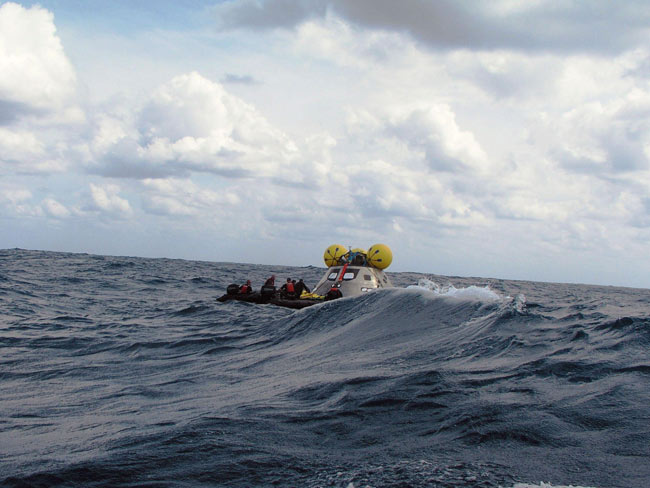NASA's New Moonship Passes Review Amid Rocket Uncertainty

NASA?s newspaceship intended to send astronauts into space and ultimately the moon haspassed an early design review amid uncertainty over whether the rocket slatedto launch it into orbit will ever fly.
Thespacecraft, a capsule-basedvehicle called Orion, passed a preliminary review this month to make sure thereare no glaring problems with the design, which NASA plans to replace its agingspace shuttle fleet. Orion capsules are slated to begin operational flights in2015 and, under the current plan, return astronauts to the moon by 2020.
?I?m veryexcited about the design of this spacecraft,? said Jeff Hanley, manager ofNASA?s Constellation program developing Orion and its Ares I rocket booster.?It?s a very capable spacecraft not just for low-Earth orbit, but also forreturning astronauts to the vicinity of the moon.?
The Orionspacecraft is a 16.5-foot (5-meter) wide capsule designed to carry at leastfour astronauts on crew change flights to the International Space Station or onlonger expeditionsto the moon. NASA originally envisioned launching six people aboard Orion,but scaled down the crew size for the first flights earlier this year in order to maintain the 2015 flight schedule.
Orion?spreliminary design review, a major project milestone, comes as uncertainlylooms over the spacecraft?s Ares I rocket, a two-stage booster slated to makeits firsttest flight on Oct. 31.
Rocketlimbo
Earlierthis month, an independent committee appointed by the White House to reviewNASA?s plans for human space exploration came up with fourgeneral options for consideration by President Barack Obama. Only one ofthose options, a baseline study, included the Ares I rocket while othersreplaced it with existing rockets or NASA?s larger, heavy-lift Ares V boosterplanned to support eventual moon missions.
Get the Space.com Newsletter
Breaking space news, the latest updates on rocket launches, skywatching events and more!
Thecommittee, led by former Lockheed Martin CEO Norman Augustine, is expected tofile a final report to the White House in upcoming weeks. Any presidentialdecision to eliminate the Ares I rocket would add years to Orion?s development,project managers said, but NASA has a wealth of experts that could be ready toreview that option.
?It?simportant for folks to understand that the rocket and the spacecraft fly as anintegrated system,? Hanley said in a Tuesday teleconference. ?So whatever we dowith respect to the launcher, we would have to go back and redo, to someextent, work that is already done.?
That couldmean a considerable reevaluation of Orion?s design, adding up to two years toNASA?s already extended development schedule. An independent report released thismonth found that NASA would have to spendbillions more than planned if it abandoned the Ares I rocket and replacedit with an human-rated Delta 4 Heavy rocket currently available for unmannedsatellite launches.
?I thinkwe?re very much staying on the plan right now until we receive new direction,?Hanley said.
To date,NASA has spent $3.1 billion developing the Orion spacecraft and $7.7 billion onthe Constellation program as a whole. The agency plans to spend about $35billion on the program through 2015. The Augustine committee has said NASA doesnot have the budget to meet its ultimate target - returning astronauts tothe moon by 2020 - unless it receives a substantial boost from the ObamaAdministration.
Orionwork ahead
Currently,the Orion crew capsule is about 300 pounds (136 kg) heavier than its targetweight of about 21,400 pounds (9,706 kg), spacecraft project manager Mark Geyertold reporters. NASA has about 1,000 pounds (453 kg) of margin and expects tohit its weight target soon, he added.
Geyer addedthat engineers still have to complete a design review of a critical cover forOrion?s landing parachutes to make sure it is safe and efficient. That is expectedto be completed soon.
The finalcritical design review for Orion, the Ares I rocket and other systems are notscheduled until about 2011 or later, when NASA would begin building flighthardware, Hanley added.
Once the Augustinecommittee submits its report, the options it compiled will be evaluated by theObama Administration and NASA?s new chief Charles Bolden, a former shuttlecommander.
?We have afew weeks left to wait and see what happens with this review and what directionCharlie Bolden and the team wants to take us,? Hanley said. ?So we wait withgreat anticipation.?
- New Video - NASA?s Ares I-X Test Flight Unveiled
- Video - Back to the Moon with NASA's Constellation
- New Video Show - NASA's Vision for Humans in Space
Join our Space Forums to keep talking space on the latest missions, night sky and more! And if you have a news tip, correction or comment, let us know at: community@space.com.

Tariq is the Editor-in-Chief of Space.com and joined the team in 2001, first as an intern and staff writer, and later as an editor. He covers human spaceflight, exploration and space science, as well as skywatching and entertainment. He became Space.com's Managing Editor in 2009 and Editor-in-Chief in 2019. Before joining Space.com, Tariq was a staff reporter for The Los Angeles Times covering education and city beats in La Habra, Fullerton and Huntington Beach. In October 2022, Tariq received the Harry Kolcum Award for excellence in space reporting from the National Space Club Florida Committee. He is also an Eagle Scout (yes, he has the Space Exploration merit badge) and went to Space Camp four times as a kid and a fifth time as an adult. He has journalism degrees from the University of Southern California and New York University. You can find Tariq at Space.com and as the co-host to the This Week In Space podcast with space historian Rod Pyle on the TWiT network. To see his latest project, you can follow Tariq on Twitter @tariqjmalik.









